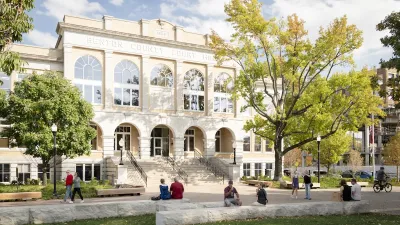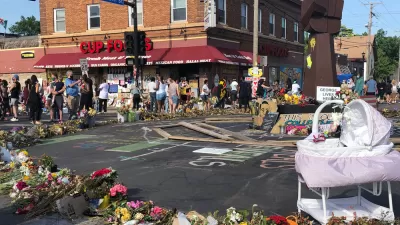A growing body of research examines the question of how to make places more attractive and healthy, without then making them more expensive.

Rebecca Tuhus-Dubrow provides access into an ongoing debate about "environmental gentrification": "Low-income communities tend to suffer from various kinds of environmental injustice, including shortage of green space. But when these concerns are addressed — the power plant closes, a park opens — the neighborhood becomes more desirable, often kickstarting a process of so-called 'environmental gentrification.'"
Researchers and advocates have proposed a "just green enough" model that "seeks to remedy injustices without introducing the fancy amenities that can radically transform a neighborhood," according to Tuhus-Dubrow.
The approach is the subject of a new paper in the journal Landscape and Urban Planning, by University of California, Berkeley professor Jennifer Wolch and coauthors.
The paper concludes with recommendations for pulling off the “careful balancing act” of improving conditions without inducing environmental gentrification, including:
- "Planners must be willing to design projects determined by specific community needs and preferences."
- "…prioritize small and scattered parks and community gardens, which can distribute access throughout a neighborhood, rather than flashy, large-scale projects of the type that tend to attract attention and real estate speculation."
FULL STORY: Pretty Park, Affordable Rent: Making Neighborhoods “Just Green Enough”

Alabama: Trump Terminates Settlements for Black Communities Harmed By Raw Sewage
Trump deemed the landmark civil rights agreement “illegal DEI and environmental justice policy.”

Planetizen Federal Action Tracker
A weekly monitor of how Trump’s orders and actions are impacting planners and planning in America.

Why Should We Subsidize Public Transportation?
Many public transit agencies face financial stress due to rising costs, declining fare revenue, and declining subsidies. Transit advocates must provide a strong business case for increasing public transit funding.

‘Clybourne Park’ Sets Stage for Housing Equity Discussions
Clybourne Park, a play exploring race, real estate, and community tensions, can set the stage for discussion on the lasting impacts of housing discrimination, gentrification, and the fight for affordability.

Understanding Road Diets
An explainer from Momentum highlights the advantages of reducing vehicle lanes in favor of more bike, transit, and pedestrian infrastructure.

New California Law Regulates Warehouse Pollution
A new law tightens building and emissions regulations for large distribution warehouses to mitigate air pollution and traffic in surrounding communities.
Urban Design for Planners 1: Software Tools
This six-course series explores essential urban design concepts using open source software and equips planners with the tools they need to participate fully in the urban design process.
Planning for Universal Design
Learn the tools for implementing Universal Design in planning regulations.
Caltrans
Smith Gee Studio
Institute for Housing and Urban Development Studies (IHS)
City of Grandview
Harvard GSD Executive Education
Toledo-Lucas County Plan Commissions
Salt Lake City
NYU Wagner Graduate School of Public Service




























